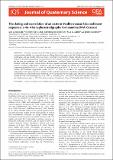Files in this item
The dating and correlation of an eastern Mediterranean lake sediment sequence : a 46–4 ka tephrostratigraphy for Ioannina (NW Greece)
Item metadata
| dc.contributor.author | McGuire, Amy M. | |
| dc.contributor.author | Lane, Christine S. | |
| dc.contributor.author | Roucoux, Katherine H. | |
| dc.contributor.author | Albert, Paul G. | |
| dc.contributor.author | Kearney, Rebecca | |
| dc.date.accessioned | 2022-07-26T15:30:11Z | |
| dc.date.available | 2022-07-26T15:30:11Z | |
| dc.date.issued | 2022-07-25 | |
| dc.identifier | 280616920 | |
| dc.identifier | cd635b5e-5710-49fd-8432-e57622eebfb9 | |
| dc.identifier | 85134680672 | |
| dc.identifier | 000829766800001 | |
| dc.identifier.citation | McGuire , A M , Lane , C S , Roucoux , K H , Albert , P G & Kearney , R 2022 , ' The dating and correlation of an eastern Mediterranean lake sediment sequence : a 46–4 ka tephrostratigraphy for Ioannina (NW Greece) ' , Journal of Quaternary Science , vol. Early View . https://doi.org/10.1002/jqs.3452 | en |
| dc.identifier.issn | 0267-8179 | |
| dc.identifier.other | RIS: urn:904240CD20527E19D79415D4EC103CA8 | |
| dc.identifier.other | ORCID: /0000-0001-6757-7267/work/116597676 | |
| dc.identifier.uri | https://hdl.handle.net/10023/25713 | |
| dc.description | AMM was funded by a PhD studentship from the Department of Geography, University of Cambridge. Initial work by CSL and PGA was supported via the NERC-funded project Response of Humans to Abrupt Environmental Transitions (RESET; NE/E015670/1). RK was supported by the NERC-funded Environmental Research Doctoral Training Program (NE/L002613/1) at the University of Oxford. | en |
| dc.description.abstract | Terrestrial archives from the Mediterranean have been crucial to expanding our understanding of past environmental variability on a range of timescales. Dating Quaternary sequences in the Mediterranean is, however, often challenging, and age models often have large chronological uncertainties. Tephra deposits can provide crucial age control for detailed environmental reconstructions on sub-centennial timescales. Here, tephra analysis is undertaken for the first time on a sediment core (I-08) from Lake Ioannina, northwest Greece, for the interval spanning 46-4 ka bp. Detailed visible and 'crypto-' tephra analysis identifies deposits associated with explosive volcanism at Italian volcanic sources, including Campi Flegrei, Pantelleria, and the Aeolian Islands. We identify two visible tephra layers, the Campanian Ignimbrite (CI/Y-5; ca. 39.8 ka bp) and Pantelleria Green Tuff (PGT/Y-6; ca. 45.7 ka), as well as the Holocene Vallone del Gabellotto cryptotephra marker (VG/E-1; ca. 8.3 ka bp). Evidence for repeated remobilisation and redeposition of CI tephra material is outlined, and the potential mechanisms and effects of sediment reworking in lake environments are examined. Bayesian modelling, which incorporates the new tephra ages with earlier radiocarbon dates, extends the I-08 core chronology back to ca. 46 ka bp, facilitating direct correlation of the Ioannina sequence to others in the Mediterranean region. | |
| dc.format.extent | 19 | |
| dc.format.extent | 3662441 | |
| dc.language.iso | eng | |
| dc.relation.ispartof | Journal of Quaternary Science | en |
| dc.subject | Ioannina | en |
| dc.subject | Last glacial cycle | en |
| dc.subject | Mediterranean | en |
| dc.subject | Palaeolimnology | en |
| dc.subject | Tephrochronology | en |
| dc.subject | GB Physical geography | en |
| dc.subject | DAS | en |
| dc.subject.lcc | GB | en |
| dc.title | The dating and correlation of an eastern Mediterranean lake sediment sequence : a 46–4 ka tephrostratigraphy for Ioannina (NW Greece) | en |
| dc.type | Journal article | en |
| dc.contributor.institution | University of St Andrews. School of Geography & Sustainable Development | en |
| dc.contributor.institution | University of St Andrews. Environmental Change Research Group | en |
| dc.identifier.doi | https://doi.org/10.1002/jqs.3452 | |
| dc.description.status | Peer reviewed | en |
This item appears in the following Collection(s)
Items in the St Andrews Research Repository are protected by copyright, with all rights reserved, unless otherwise indicated.

